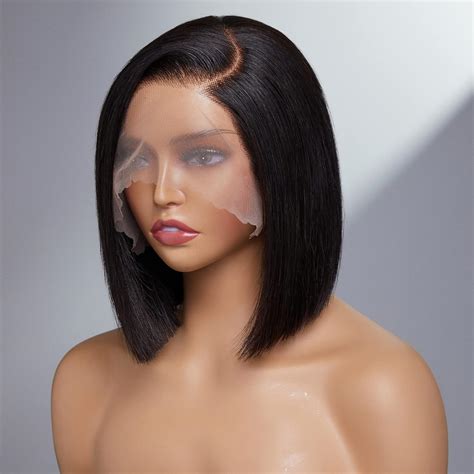Understand the Concept of Wigs & Half Wigs
Wigs are non-surgical hair replacements that cover the entire head, while half wigs (also known as toppers or hair toppers) cover only the crown or a specific area of the head. Both options provide instant hair volume, concealing hair loss, thinning, or damage.

Types of Wigs
1. Full Lace Wigs:
– Hand-tied lace provides a realistic scalp appearance.
– Allow for versatile styling, including high ponytails and buns.
– More expensive and require professional installation.
2. Lace Front Wigs:
– Lace panel at the hairline creates a natural-looking front.
– Less expensive than full lace wigs.
– Can be trimmed to customize the hairline.
3. Capless Wigs:
– Machine-made with an open cap construction.
– Lightweight and breathable, suitable for warmer climates.
– May not be as durable as lace wigs.
Types of Half Wigs
1. Clip-In Toppers:
– Attached with clips to the existing hair.
– Easy to remove and reattach.
– Ideal for adding instant volume and coverage to specific areas.
2. Halo Toppers:
– Made of a wire or band that sits under the hair.
– Convenient to wear and adjust.
– May not be as secure as clip-in toppers.
Benefits of Wigs & Half Wigs
1. Hair Loss Coverage:
– Conceal thinning, alopecia, or balding.
– Regain confidence and boost self-esteem.
2. Style Versatility:
– Experiment with different colors, lengths, and textures.
– Avoid damaging your natural hair from styling products and treatments.
3. Convenience:
– Half wigs offer a quick and easy way to enhance hair volume.
– Wigs provide a complete and instant hair transformation.
Choosing the Right Option
Consider your hair loss pattern:
– Half wigs are ideal for partial hair loss or thinning on the crown.
– Full wigs are suitable for complete hair loss.
Determine your scalp sensitivity:
– Lace wigs are more breathable and less irritating for sensitive scalps.
Set a budget:
– Half wigs are typically less expensive than full lace wigs.
Half Wigs: A Unique Innovation for Hair Enhancement
Half wigs, also known as toppers or hair toppers, offer a unique solution for addressing hair loss or thinning on the crown or specific areas of the head. These hairpieces provide instant volume and coverage, creating a natural-looking appearance. Unlike full wigs, toppers are designed to complement your existing hair, allowing you to blend them seamlessly.
Benefits of Half Wigs:
Targeted Coverage:
Half wigs address hair loss or thinning in specific areas, such as the crown or part line, without covering the entire head.
Natural Blending:
The hairpiece is designed to match your natural hair color and texture, creating a seamless and natural-looking blend.
Versatile Styling:
Half wigs allow you to style your own hair as usual, enabling you to achieve a variety of looks, from sleek updos to loose curls.
Easy Maintenance:
Unlike full wigs, half wigs are easy to remove and maintain. They can be washed and styled like regular hair extensions.
Choosing the Right Half Wig
Matching Hair Color and Texture:
Select a hairpiece that closely matches your natural hair color and texture to ensure a seamless blend.
Determining the Right Size:
Measure the area of hair loss or thinning to determine the appropriate size of the hair topper.
Considering Base Type:
Choose a base type that suits your lifestyle and needs, such as lace, silk, or mono-filament.
Table 1: Types of Wigs and Their Features
| Wig Type | Lace | Cap Construction | Styling Options |
|---|---|---|---|
| Full Lace | Hand-tied lace | Breathable and realistic | Versatile styling |
| Lace Front | Lace panel at hairline | Less breathable | High ponytails and buns limited |
| Capless | Machine-made with open cap | Lightweight and breathable | May not be as durable |
Table 2: Benefits of Half Wigs and Wigs
| Benefit | Hair Loss Coverage | Style Versatility | Convenience |
|---|---|---|---|
| Half Wigs | Partial hair loss coverage | Complements natural hair | Instant volume and coverage |
| Wigs | Complete hair loss coverage | Unlimited styling options | Quick and easy transformation |
Half Wigs vs. Wigs: Pros and Cons
Half Wigs
Pros:
- Targeted hair loss coverage
- Natural-looking blend
- Convenient to wear and remove
- Less expensive than full wigs
Cons:
- May not provide enough volume for complete head coverage
- Can be difficult to style over long hair
Wigs
Pros:
- Complete hair loss coverage
- Unlimited styling options
- Boost self-confidence
- Protect natural hair from damage
Cons:
- More expensive than half wigs
- Can be time-consuming to install and remove
- May not feel as comfortable on sensitive scalps
Table 3: Types of Half Wigs
| Half Wig Type | Attachment Method | Coverage Area |
|---|---|---|
| Clip-In Toppers | Clips | Crown or specific areas |
| Halo Toppers | Wire or band | Crown area |
| Mono Toppers | Adhesive or clips | Crown area |
| Crown Extensions | Adhesive | Crown and surrounding areas |
Table 4: Factors to Consider When Choosing a Half Wig
| Factor | Considerations |
|---|---|
| Hair Loss Pattern | Partial hair loss or thinning on the crown |
| Scalp Sensitivity | Lace toppers for sensitive scalps |
| Budget | Half wigs are typically less expensive |
